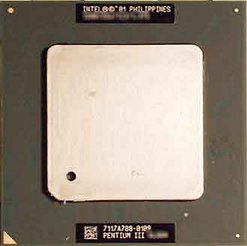Intel Pentium III Tualatin 1.067Ghz
|
We'll take a look at the stock performance at 1067Mhz (8 x 133) and then try our hand at overclocking the processor using the front side bus (remembering that Intel processors are multipler locked). Intel reference boards aren't known for their overclockability due to lack of processor voltage adjustment and the D815EFV is no different offering no voltage adjustment. First off the results from Sandra at stock and overclocked speeds. CPU Arithmetic Benchmark (1067, 8 x 133) 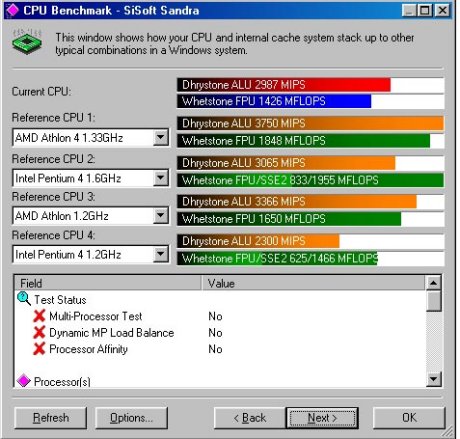 CPU Multimedia Benchmark (1067, 8 x 133) 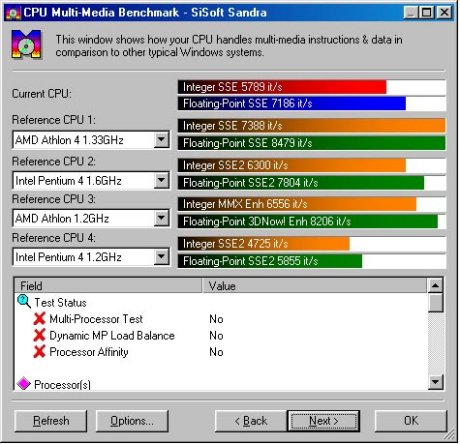 As we can see, the processor does away with the 1.2Ghz P4 reference CPU with ease and approaches the performane of the 1.2Ghz TBird Athlon. Not amazing performance these days but respectable in the company it keeps within the test version of Sandra. The 1.33Ghz Athlon and 1.6Ghz Pentium 4 take the honours here. We were pleasantly surprised to find the test system including board, processor and memory were able to run flawlessly at 160fsb. No voltage change for either processor or memory module (running at FSB of 160Mhz) and everything was super stable. CPU Arithmetic Benchmark (1280, 8 x 160) 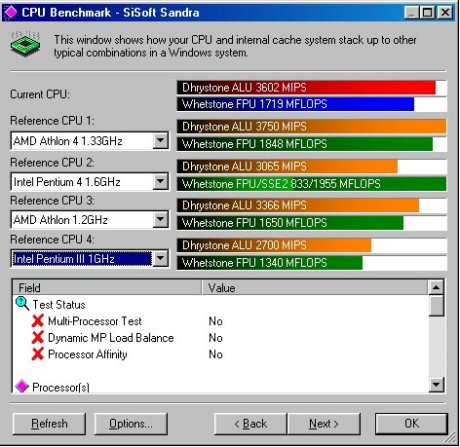 CPU Multimedia Benchmark (1280, 8 x 160)  As the CPU gets quicker it naturally starts to catch up on the 1.33Ghz Athlon and its bigger, badder brother the 1.6Ghz Pentium 4 in the reference Sandra results. At 160fsb the numbers look very good with impressive floating point multimedia performance being the quickest in the group, beating all reference processors. Impressive that the CPU was easily able to scale to this speed with no volatge increase, one of the benefits of the jump to 0.13u. The final stable speed for the processor, motherboard and memory with their total lack of voltage adjustment turned out to be 166fsb giving a processor speed of 1333Mhz. Excellent performance from the processor and given the right board and memory module would surely hit 1.4Ghz and above. Excellent overclockers for sure. At this speed the memory was running at 166Mhz CAS2 and the memory was the limiting factor here. The processor would go even further with the right memory module and all without a voltage change. CPU Arithmetic Benchmark (1333, 8 x 166) 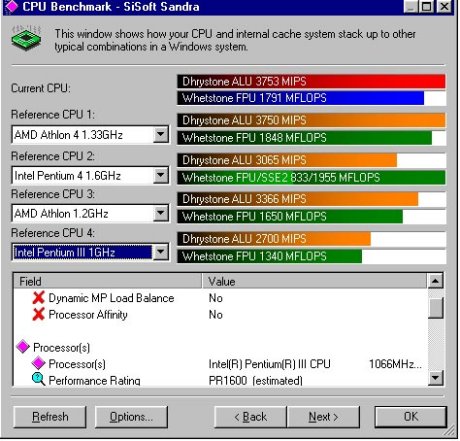 CPU Multimedia Benchmark (1333, 8 x 166)  Clocked as it was to 1.33Ghz, the processor became the fastest on test out of the reference Sandra processors, beating the 1.33Ghz Athlon and also the 1.6Ghz Pentium 4. You can now see why Intel has priced the new 0.13 Tualatin Pentium III Processors higher than its Pentium 4 processor since the P3's are actually quicker in some applications than Intel's new baby, the P4. So we can see that with Sandra, the overclocked Tualatin was an excellent performer, beating all the test processors. The lack of voltage options on the motherboard, especially for the memory stopped us from going undeniably faster. Finally to round off the look at performance we'll take a quick peek at POVRay and see how the performance compares to some of the processors we've looked at recently. 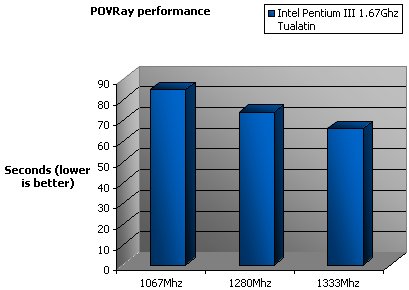 As we can see, the performance increase (remember lower is better) is linear with regards to FSB and the processor managing to run our recompiled Pentium III binary test in 66 seconds when clocked to 1333Mhz (166fsb). This compares to 55 seconds for a 2Ghz Pentium 4 and 54 seconds for a 1.33Ghz AMD Athlon XP1500 all running the same binary test. The CPU turns out to be the slowest of the group by over 10 seconds (approx 20% slower) but still puts in an admirable real world performer. The Tualatin beats a slower clocked (1.6Ghz) P4 handily in the POVRay test when the Tualatin is run at 1333Mhz but can't compete with the superior performance of the AthlonXP 1.33Ghz and is 20% slower. Overall, given the test platform a good performance from the processor, especially when overclocked. High praise for the overclock at standard CPU voltage and a pity we didn't have a more suitable motherboard in the labs to really push the CPU hard. Undoubtedly enjoying the die shrink however and a nice performance in its performance group. Conclusion The Tualatin core processors mark the end of the Pentium III blood line and many will be sad to see them go. They breathe new life into the processor range only to be marred by high price and low availability. It's clear that Intel would like the world to migrate to Pentium 4 as soon as possible. However if you are a staunch supporter of Socket 370 P3's and SDR SDRAM, you could do worse than the 1.067Ghz Tualatin Pentium III Processor as a last gasp upgrade before forcing yourself to make the leap to current generation Intel or AMD platforms The performance doesn't compare anywhere near todays systems, especially since the processor is crippled memory bandwidth wise at 133Mhz FSB using SDR memory. Open the taps a little and with the CPU begging to be overclocked, you might just find yourself with the final word in SDR performance on this generation of processor. Pick up these little pieces of computing history if you can since they are fine performers and overclock like champions. Remember that it also has a big brother in the 1.2Ghz Tualatin and that the current Celerons are also based on the core (with less L2 cache memory) and there are a few processors to choose from if you are locked to the S370 platform. Nice 0.13u practise from Intel and you can certainly do worse than one of these when shopping for a Socket 370 processor. |






